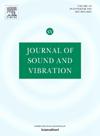Installation effects on airfoil self-noise estimated by direct numerical simulations
IF 4.3
2区 工程技术
Q1 ACOUSTICS
引用次数: 0
Abstract
Several Direct Numerical Simulations (DNS) have been achieved using the Lattice-Boltzmann Method (LBM) on a Controlled-Diffusion (CD) airfoil at and to evaluate installation effects on airfoil self-noise. 2D DNS provides unrealistic airfoil noise sources and a significant overprediction of the far-field noise with possibly a change in the ranking of the noise sources. Conversely, all 3D simulations of the airfoil immersed in the wind tunnel jet show excellent agreement with the flow around the airfoil and the far-field noise. Two new 3D DNS with some shear-layer refinement and possibly an additional zigzag trip to trigger turbulence have better resolved the jet development. Even though all 3D DNS identify two main noise sources, the laminar separation bubble (LSB) at the leading edge and the turbulent eddies at the trailing edge, their intensity varies because of a strong coupling between the jet and the airfoil that yields different LSB sizes, increased inlet turbulent intensity, oscillations of the angle-of-attack, and variations in the noise sources. The state of the jet shear layer at the nozzle exit of a given open-jet anechoic wind tunnel is seen to influence the flow field around the airfoil and its noise radiation, with potentially a larger jet contribution.

求助全文
约1分钟内获得全文
求助全文
来源期刊

Journal of Sound and Vibration
工程技术-工程:机械
CiteScore
9.10
自引率
10.60%
发文量
551
审稿时长
69 days
期刊介绍:
The Journal of Sound and Vibration (JSV) is an independent journal devoted to the prompt publication of original papers, both theoretical and experimental, that provide new information on any aspect of sound or vibration. There is an emphasis on fundamental work that has potential for practical application.
JSV was founded and operates on the premise that the subject of sound and vibration requires a journal that publishes papers of a high technical standard across the various subdisciplines, thus facilitating awareness of techniques and discoveries in one area that may be applicable in others.
 求助内容:
求助内容: 应助结果提醒方式:
应助结果提醒方式:


